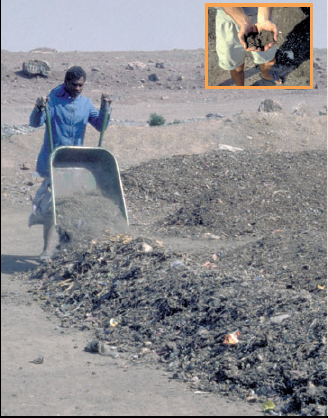Difference between revisions of "Co-composting"
Lagerstrom (talk | contribs) (creating content) |
(New icon) |
||
| Line 1: | Line 1: | ||
| − | [[Image:Co-composting_icon. | + | [[Image:Co-composting_icon.jpg|right]] |
Composting is an aerobic process in which bacteria and other organisms feed on organic material and decompose it. Composting (one material) and co-composting (two or more materials) represent generally accepted procedures to treat excreta. To start the composting process, the blended compostable material is placed in windrows (long or round piles). The `recipe' combines high-carbon and high-nitrogen materials. Air is added to maintain aerobic conditions, either by turning the windrows or by forcing air through them. To adequately treat excreta together with other organic materials in windrows, the WHO (1989) recommends active windrow co-composting with other organic materials for one month at 55-60°C, followed by two to four months curing to stabilise the compost. This achieves an acceptable level of pathogen kill for targeted health values. Adding excreta, especially urine, to household organics produces compost with a higher nutrient value (N-P-K) than compost produced only from kitchen and garden wastes. Co-composting integrates excreta and solid waste management, optimizing efficiency. | Composting is an aerobic process in which bacteria and other organisms feed on organic material and decompose it. Composting (one material) and co-composting (two or more materials) represent generally accepted procedures to treat excreta. To start the composting process, the blended compostable material is placed in windrows (long or round piles). The `recipe' combines high-carbon and high-nitrogen materials. Air is added to maintain aerobic conditions, either by turning the windrows or by forcing air through them. To adequately treat excreta together with other organic materials in windrows, the WHO (1989) recommends active windrow co-composting with other organic materials for one month at 55-60°C, followed by two to four months curing to stabilise the compost. This achieves an acceptable level of pathogen kill for targeted health values. Adding excreta, especially urine, to household organics produces compost with a higher nutrient value (N-P-K) than compost produced only from kitchen and garden wastes. Co-composting integrates excreta and solid waste management, optimizing efficiency. | ||
Revision as of 15:01, 18 July 2008
Composting is an aerobic process in which bacteria and other organisms feed on organic material and decompose it. Composting (one material) and co-composting (two or more materials) represent generally accepted procedures to treat excreta. To start the composting process, the blended compostable material is placed in windrows (long or round piles). The `recipe' combines high-carbon and high-nitrogen materials. Air is added to maintain aerobic conditions, either by turning the windrows or by forcing air through them. To adequately treat excreta together with other organic materials in windrows, the WHO (1989) recommends active windrow co-composting with other organic materials for one month at 55-60°C, followed by two to four months curing to stabilise the compost. This achieves an acceptable level of pathogen kill for targeted health values. Adding excreta, especially urine, to household organics produces compost with a higher nutrient value (N-P-K) than compost produced only from kitchen and garden wastes. Co-composting integrates excreta and solid waste management, optimizing efficiency.
| Advantages | Disadvantages |
|---|---|
| Flexible approach with highly variable capacity. Toilet paper is decomposed. |
Operation and maintenance requires moderate professional experience. Limited control of vectors and pest attraction. |
Costs
- Operation costs US$ 5-30 /ton composted material (costs are higher on smaller sites).
- Capital costs - Depend on scale, space available, and design choices.
Applying conditions
- The type of material, the climate, the amount of space and the equipment and funds available all influence the system design, especially windrow type and size, recipe, and level of technology.
- Special measures, such as more frequent turning or covering the piles can accommodate extremes of climate or temperature.
- Composting is a bio-chemical process, not a bio-mechanical one, and as such requires experience and practical knowledge, together with a high level of management.
External links
- General information about Co-composting www.ecosanres.org
- General information www.gtz.de/ecosan
- General information www.sandec.ch
- General information www.waste.nl

